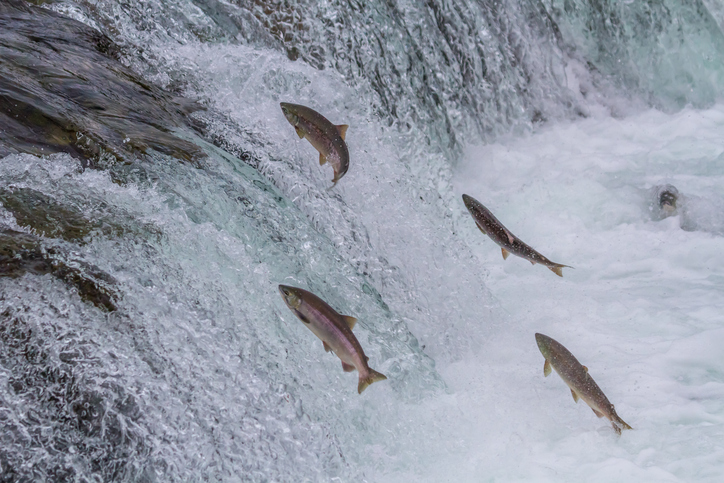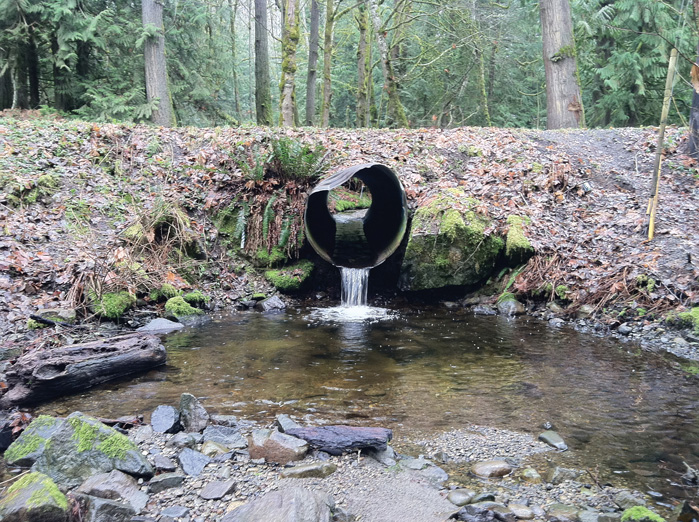Salmon Recovery Continues to Be an Upstream Battle

Sockeye salmon
jumping up falls during the annual migration.
Salmon are taking a beating in Washington state.
According to a comprehensive study by the Northwest Indian
Fisheries Commission, wild
salmon populations continue to decline because of
culverts, which block fish migration; shoreline modifications,
which affect nearshore habitat; impervious road surfaces, which
result in more polluted stormwater runoff; loss of forestland cover
that provides nutrients and shade for streams; and an increase in
the number of wells, which use water needed to recharge aquifers and
streams.
The result: according to the Washington state Department of Fish
and Wildlife, between 75 and 90 percent of salmon caught in
Washington are hatchery-bred.
“The battle for salmon recovery is being lost for one main reason:
Salmon habitat is disappearing faster than we can restore it,” the late
Billy Frank Jr., NWIFC chairman, wrote in The Seattle Times
on February 16, 2014. “The treaty Indian tribes are leading the fight
for salmon recovery. We bring funding, operate hatcheries, conduct
research, restore and protect habitat and share traditional knowledge of
local watersheds to benefit everyone who lives in Washington.”
And so state Attorney General Bob Ferguson’s August 17 petition
before the U.S. Supreme Court, challenging a lower court ruling that the
state must replace more than 800 state-owned culverts that block fish
passage, drew responses ranging from concern to rebuke from Native and
state leaders.
“This is a sad day for Washington state,” Swinomish Chairman Brian
Cladoosby said in a statement released by his office after Ferguson
filed his petition with the high court. Cladoosby is also president of
the National Congress of American Indians.
“We haven’t seen an attack on tribal treaty rights like this by the
State of Washington in a very long time. It is my understanding that the
state agencies responsible for repairing fish-blocking culverts asked
him not to do this. [Attorney General] Ferguson has gone out of his way
to attempt to undermine our treaties and our way of life. By this
petition, [he] is arguing that it is perfectly OK for the state to
destroy thousands of acres of salmon habitat without any consequence. It
is an outrageous claim, the 9th Circuit [Court of Appeals] rejected it
and we will fight him with all the strength we have.”
In 2013, U.S. District Court Judge Ricardo Martinez gave the state 17
years to replace its most troublesome culverts. Doing so is expected to
cost the state as much as $2 billion. The 9th Circuit Court of Appeals
upheld Martinez’s ruling.

Courtesy Northwest Treaty Tribes
Ready … set … jump. The
State of Washington is under federal court order to replace culverts
it owns like this one. A federal court judge ruled that such
culverts block fish migration. Washington Attorney General Bob
Ferguson has asked for the U.S. Supreme Court to reconsider the
ruling, saying the feds should share the cost of culvert
replacement.
In an announcement of his petition before the U.S. Supreme Court,
Ferguson outlined reasons he is seeking the high court’s review of the
appeals court’s decision.
Money should be spent on “more effective restoration
efforts”: “The 9th Circuit’s decision forces the state to
expend resources on projects that will not benefit salmon,” Ferguson
stated. “The decision requires the state to replace culverts even when
other barriers, such as dams or federal culverts, block salmon from ever
reaching the state’s culvert. Money squandered on such projects could
and should instead be used for more effective salmon restoration
efforts.”
Feds share some responsibility: “The lower court
decision forces state taxpayers to pay for problems largely created by
the federal government,” Ferguson stated. “For decades, the federal
government specified the design for the state’s highway culverts. The
state then invented and began using a new design that is better for
salmon. Then, the federal government sued Washington over the old
culverts designed to federal standards. The petition asks that the
federal government be blocked from bringing its claim, or at least be
required to contribute to the cost of fixing the federally designed
culverts.”
There are other causes of salmon population decline:
“While Washington is committed to protecting salmon — spending hundreds
of millions toward this goal in recent years — many factors beyond the
state’s control affect [the salmon population] … including global
climate change and ocean acidification,” Ferguson stated. “Therefore,
the state may be unable to comply with the court’s order if factors
outside the state’s control negatively affect the salmon population,
regardless of how many culverts it restores.”
Ferguson said he supports culvert replacement and that “the state
should increase the pace of culvert replacement.” But he hinted that the
state – which is struggling to meet court mandates that it adequately
fund basic education and improve the state’s provision of mental health
services – may not have the money to replace culverts in the timeframe
set by Martinez. According to the
Northwest Indian Fisheries Commission’s math, the current pace at
which the state is replacing its culverts puts completion in 2060, 30
years after the deadline.
“I will support any proposal from the Legislature, the governor or
other public officials who control land use and spending decisions that
would accelerate the pace of culvert replacements,” Ferguson said. “The
state should not need a court order to restore salmon habitat.”
According to Ferguson’s office, the Supreme Court is expected to
decide whether to take the case in fall 2017. If the court decides to
hear the case, it will be argued in spring 2018, with a decision before
adjournment in June that year.
Meanwhile, state Commissioner of Public Lands Hilary Franz, who heads
the state Department of Natural Resources, wrote in an August 11 letter
to Ferguson that she opposed an appeal. She wrote Ferguson that the
state should instead “work collectively and focus on actions that
address and actively aid the many concerns that our tribal governments —
and so many of our non-tribal residents — have been raising for years”
regarding culverts and the hindrance they pose to fish migration.
Franz reported in May the results of collective action. On her blog,
she wrote that 43 large forest landowners – among them corporations, two
cities and a Native corporation – upgraded 25,000 miles of forest road
and removed 6,000 fish-passage barriers to re-open about 3,500 miles of
upstream habitat to migrating fish. And they did it before the state
Forest Practices Board deadline of 2021. In addition, more than 50 other
large forest landowners are in the midst of making required
improvements, Franz reported.
“Their efforts are worthy of special recognition because they
completed their work on time, and despite the many challenges of a major
economic recession,” Franz wrote.
Lorraine Loomis, chairwoman of the Northwest Indian Fisheries
Commission, said of the state’s responsibility to replace the culverts
it owns: “Fixing fish-blocking culverts under state roads will open up
hundreds of miles of habitat and result in more salmon. That means more
fishing, more jobs and healthier economies for all of us …
“Reserving the right to fish so that we can feed our families and
preserve our culture was one of the tribes’ few conditions when we
agreed to give up nearly all of the land that is today western
Washington. The treaties our ancestors signed have no expiration date
and no escape clauses.”
Issue At A Glance
Indigenous leaders in what became the state of Washington signed
seven treaties with the United States in 1854-56, ceding land to the
U.S. in exchange for certain considerations. In addition, those leaders
reserved land for their people, as well as “The right of taking fish, at
all usual and accustomed grounds and stations.”
Article VI of the U.S. Constitution states that treaties are the
supreme law of the land. The treaties signed between the U.S. and
indigenous nations have as much weight under the Constitution as
treaties between the U.S. and other governments.
U.S. District Court Judge George H. Boldt upheld Indian treaty
fishing rights in his 1974 decision in U.S. v. Washington. His
decision established the treaty tribes and the State of Washington as
co-managers of the state’s salmon population.
© 2017 Indian Country Today Media Network, all rights
reserved.
https://indiancountrymedianetwork.com
https://indiancountrymedianetwork.com/news/environment/salmon-recovery-continues-upstream-battle
|

